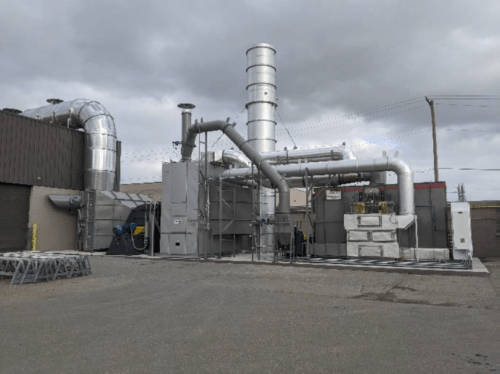The Challenge
A family-owned manufacturer of metal wall and roofing systems in the Midwest was looking to expand their production capabilities while taking advantage of local utility rebate programs. Their existing operation contained three painting booths venting directly to atmosphere. As a part of the expansion, they planned to install two new paint booths, which would require them to install pollution abatement equipment.
Their application presented the following design challenges for the required emission control solution:
- The five paint booths represented a very large process stream containing volatile organic compounds (VOCs) including toluene, xylene, and
ethylbenzene.
- The solution needed to process up to 90,000 SCFM of VOC-laden air with a minimum of 95% overall destruction efficiency.
- Space was also a major concern, as the equipment needed to fit in a tight space.
- They wanted to maximize energy rebates through their local utility provider, who offered prescriptive measures for the installation of pollution control equipment.
They solicited proposals from several air pollution control equipment suppliers including Anguil, another Midwestern family-owned business.
The Solution
With such a large airflow from five paint booths, Anguil engineers quickly identified the emission concentrator system as the most cost-effective choice, proposing a 90,000 SCFM Rotary Zeolite Emission Concentrator Wheel combined with a 7,500 SCFM Regenerative Thermal Oxidizer (RTO).
Even though RTOs are extremely efficient and effective destruction devices, they rely on a steady stream of process emissions to fuel combustion of incoming contaminants. When coupled with a concentrator, the oxidizer consistently receives highly concentrated streams in a much smaller volume.
The selection of concentrator is easy to justify at this flowrate when compared to a standalone 90,000 SCFM RTO with similar footprint. While the capital cost of a concentrator and oxidizer combination is typically more expensive than the RTO without concentration, the proposed system would use dramatically less energy, which would reduce operating costs and greenhouse gas emissions. The reduction in natural gas and electricity usage would also make the manufacturer eligible for energy rebates in their state.
Their local utility company offers rebate program for customers that implement energy efficiency measures. Their current program has prescriptive measures for the installation of gas fired equipment like thermal and catalytic oxidizers. Under this program, the customer was eligible for a $37,500 rebate ($5.00/cfm for 2 shift operation x 7500 SCFM RTO).
Anguil’s local sales representative approached the utility company engineers with the possibility of doing a custom energy analysis since the concentrator system was even more efficient than a standard RTO. Anguil showed the energy consumption of the concentrator system and modeled it against a 90,000 SCFM RTO. This showed that the concentrator system would use 771,450 kWh/ year ($0.05/kWH incentive) and 51,393.82 MCF of natural gas/year ($3.50/MCF incentive). This calculated to a $218,000 rebate.
The utility company engineers brought the project to an external consulting company that provides oversight and regulatory compliance for the energy providers and their rebate programs. The consulting company agreed that the baseline should be a recuperative oxidizer, a less thermally efficient style of thermal oxidizer. This brought the energy savings up to 689,788 kWh electric and 209,094 MCF in natural gas savings for a total energy incentive of $766,319.00! However, there is a $300,000 cap per customer for natural gas payouts.
The Result
- With persistence and a strategic focus on maximizing the energy rebate program, Anguil was able to secure the project and increase the customer’s total project rebate from an initial $37,500 to $300,000 – that’s an additional $262,500 savings!
- The utility company determined to pay approximately half of the incentive for the program year 2020 and the balance in 2021 to better accommodate
their savings goal and this also removed the payout cap so that the customer received the full amount through both program years.
- Since this was the customer’s first experience with emission control equipment, Anguil provided 10 days of start-up assistance and staff classroom training to ensure familiarity with their new state-of-the-art pollution control system.
Anguil has built upwards of 60 emission concentrator installations in the past five years and is well-regarded as an industry leader with this technology. Anguil’s extensive experience with emission concentrators and successful advocacy for a significant custom energy savings program gave the customer confidence in their selection for the project. In addition, Anguil’s similarity to the customer’s Midwestern, family-run business assured that they would be taken care of and would enjoy accessible communication and project transparency.

 ethylbenzene.
ethylbenzene. their savings goal and this also removed the payout cap so that the customer received the full amount through both program years.
their savings goal and this also removed the payout cap so that the customer received the full amount through both program years.